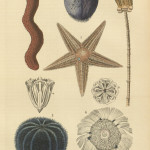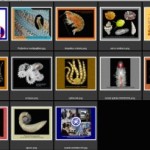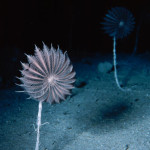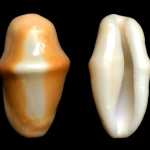The recent Invertebrate Wars reminded me of spectacular, but often ignored, group of gastropods. The parasites! This is a group that I have totally geeked out on in the past. In my previous work I have focused on the Ptenoglossa likely a paraphyletic or polyphyletic group, established originally of unspecified rank by Gray (1853). It is generally agreed upon that the group is above the level of family and generally is defined as a suborder (Bouchet & Rocroi 2005). The group includes usually includes the families Cerithiopsidae, Triphoridae, Janthinidae, Epitoniidae, Aclidae, and the Eulimida. Most ptenoglosates possess radulae distinctive to the group (Ponder & Lindberg 1997).
Most eulimids are highly specialized and exclusively ectoparasitic (external parasites) on echinoderms. Most are permanently attached to a single host, although some species may transfer between hosts repeatedly during their lifespan. However a few species have undergone numerous morphological adaptations, including anatomical reductions, to exploit hosts as endoparasites particularly on the sea cucumbers! Shell morphology can be extremely variable, reflecting specialization for parasitism, with males typically smaller than females. Epitoniids are generally considered to be ectoparasites, although some authors have defined this group by various degrees of commensalism and predation (Smith 1998). In contrast to eulimids, epitoniids are exclusively ectoparasitic on cnidarians, primarily anemones and corals, and reside in the sediment near their hosts. A modified radula and jaw are used to bite pieces of their hosts. The host specificity of aclids is less clear is not known. Cerithiopsidae and Triphoridae feed on sponges possibly in a manner that could be construed as parasitic. The Janthinidae, or violet snails, are parasites on the various pelagic Cnidarians like Portuguese Man-‘O-War, Porpita, and Velella.
So its obvious once again that Mollusks, specifically Gastropods, are better than cnidarians and echinoderms (capitalization, or lack thereof, is intended)
See below for pictures.

Janthina globosa feeding on Porpita

Eulimid on crinoid


Examples of Epitoniids (Wentletraps)


Eulimid snail on Ophiothrix sp

Parasitic Eulimid Shell on a Fire Urchin






Wonderful and concise post about an entire category of organisms of which I was unaware. Thanks!
Is there such a thing as a parasitic Echinoderm? I can’t recall hearing of any.
So, the ability to evolve parasitic lifeforms is a hallmark of superiority? Please, these molls are so pathetically frightened of the ‘real’ world that they have to mooch off others to survive. Sad, how sad.